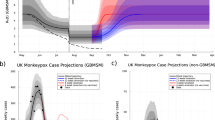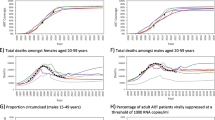Abstract
This study critically evaluates the quality of 1990 back-calculations and long-term projections of the HIV/AIDS epidemic for homosexual/bisexual men in France, the Federal Republic of Germany, and the UK. The projection captured the general pattern observed in all three countries although the observed AIDS incidence peaked 2–3 years later and declined faster than had been projected. Total AIDS incidences from 1989 to 2000 were overestimated by 38.5% in France, and underestimated by 23.9 and 17.5% in western Germany and the UK. Updated back-calculations and projections to 2020 use AIDS incidence data up to 2000. The procedure incorporates an asymmetric long-tailed cumulative HIV curve as well as the increase in the median incubation period brought about by new therapies introduced during the 1990s. The results suggest that: (i) The rapid decrease in cases during the late 1990s was caused by a median incubation period that increased from 10 years to 21–23 years by the late 1990s. (ii) An imminent bottoming out followed by a protracted increase in AIDS cases from 2000 to at least 2010 could be the consequence of a leveling off of the median incubation period. (iii) A low variant of the projections shows that at least 40,000 homosexual men could develop AIDS in the three countries after 2000.
Similar content being viewed by others
References
Artzrouni M. Projections of the HIV/AIDS epidemic for homosexual/bisexual men in France, the Federal Republic of Germany, and the United Kingdom. Eur J Epidemiol 1990; 6: 124–135.
Egger M, May M, Chene G, Phillips AN, Ledergerber B, Dabis F. Prognosis of HIV-1-infected patients starting highly active antiretroviral therapy: A collaborative analysis of prospective studies. Lancet 2002; 360: 119–129.
Jacobson LP, Li R, Phair J, et al. Evaluation of the effectiveness of highly active antiretroviral therapy in persons with human immunodeficiency virus using biomarker-based equivalence of disease progression. Am J Epidemiol 2002; 155: 760–770.
Gange SJ, Barren Y, Greenblatt RM, et al. Effectiveness of highly active antiretroviral therapy among HIV-1 infected women. J Epidemiol Commun Health 2002; 56: 153–159.
Brookmeyer R, Gail M. A method for obtaining short-term projections and lower bounds on the size of the AIDS epidemic. JASA 1988; 83: 301–308.
Verdecchia A, Mariotto AB. A back-calculation method to estimate the age and period HIV infection intensity, considering the susceptible population. Stat Med 1995; 14: 1513–1530.
Lui KJ, Darrow WW, Rutherford GW. A model-based estimate of the mean incubation period for AIDS in homosexual men. Science 1988 240(4857); 1333–1335.
Hendriks JC, Satten GA, Longini IM, et al. Use of immunological markers and continuous-time Markov models to estimate progression of HIV infection in homosexual men. AIDS 1996; 10: 649–656.
Cooley PC, Myers LE, Hamill DN. A meta-analysis of estimates of the AIDS incubation distribution. Eur J Epidemiol 1996; 12: 229–235.
Chevret S, Costagliola D, Lefrere JJ, Valleron AJ. A new approach to estimating AIDS incubation times: Results in homosexual infected men. Epidemiol Commun Health 1992; 46: 582–586.
Gail MH, Rosenberg PS, Goedert JJ. Therapy may explain recent deficits in AIDS incidence. J Acquir Immune Defic Syndr 1990; 3: 296–306.
European Centre for the Epidemiological Monitoring of AIDS. HIV/AIDS Surveillance in Europe. Mid-year report 2002. 2002, No 67.
Institut de Veille Sanitaire. SIDA, VIH et IST. Etat des lieux des données en 2002. 2002.
Rosenberg PS, Gail MH, Carroll RJ. Estimating HIV prevalence and projecting AIDS incidence in the United States: A model that accounts for therapy and changes in the surveillance definition of AIDS. Stat Med 1992; 11: 1633–1655.
Artzrouni M. A modeled time-varying density function for the incubation period of AIDS. J Math Biol 1992; 31: 73–99.
Tassie JM, Grabar S, Lancar R, et al. Time to AIDS from 1992 to 1999 in HIV-1-infected subjects with known date of infection. J AIDS 2002 1; 30: 81–87.
Downs AM, Heisterkamp SH, Rava L, Houweling H, Jager JC, Hamers FF. Back-calculation by birth cohort, incorporating age-specific disease progression, pre-AIDS mortality and change in European AIDS case definition. European Union Concerted Action on Multinational AIDS Scenarios. AIDS 2000 29; 14: 2179–2189.
Author information
Authors and Affiliations
Corresponding author
Rights and permissions
About this article
Cite this article
Artzrouni, M. Back-calculation and projection of the HIV/AIDS epidemic among homosexual/bisexual men in three European countries: Evalution of past projections and updates allowing for treatment effects. Eur J Epidemiol 19, 171–179 (2004). https://doi.org/10.1023/B:EJEP.0000017826.57607.ea
Issue Date:
DOI: https://doi.org/10.1023/B:EJEP.0000017826.57607.ea




